2023学年高考英语一轮复习构词法课件(30张ppt)
文档属性
| 名称 | 2023学年高考英语一轮复习构词法课件(30张ppt) |  | |
| 格式 | zip | ||
| 文件大小 | 4.2MB | ||
| 资源类型 | 教案 | ||
| 版本资源 | 通用版 | ||
| 科目 | 英语 | ||
| 更新时间 | 2022-10-24 11:46:02 | ||
图片预览

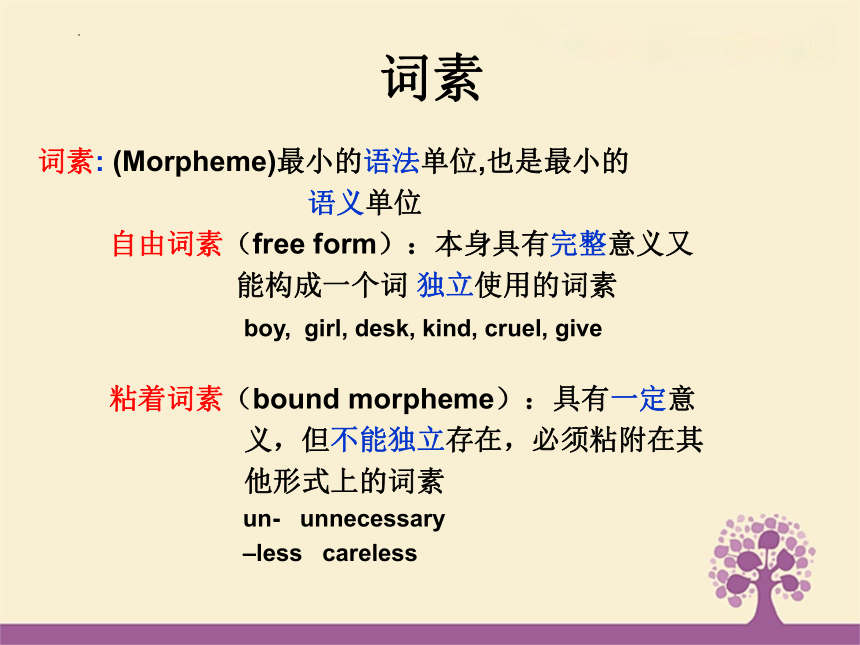

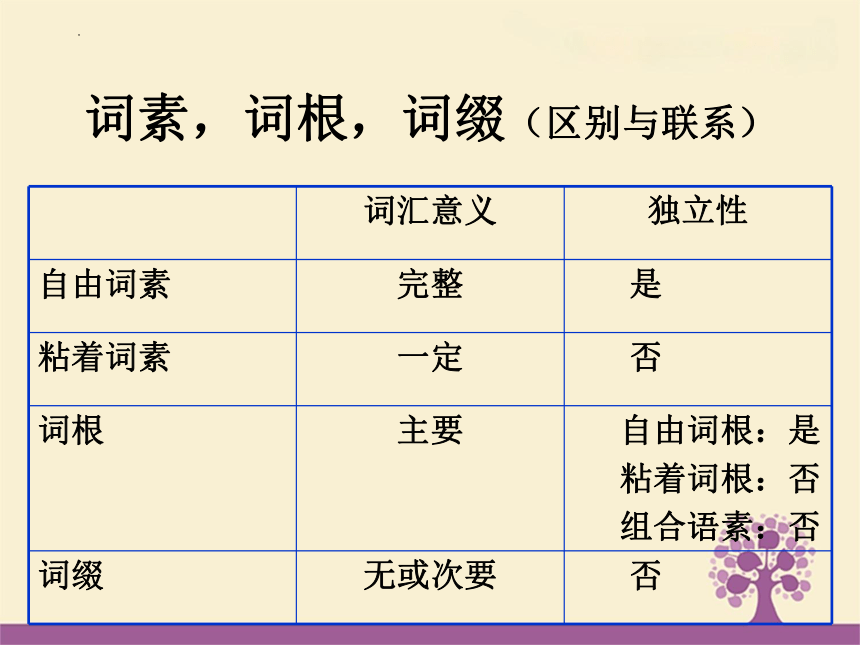
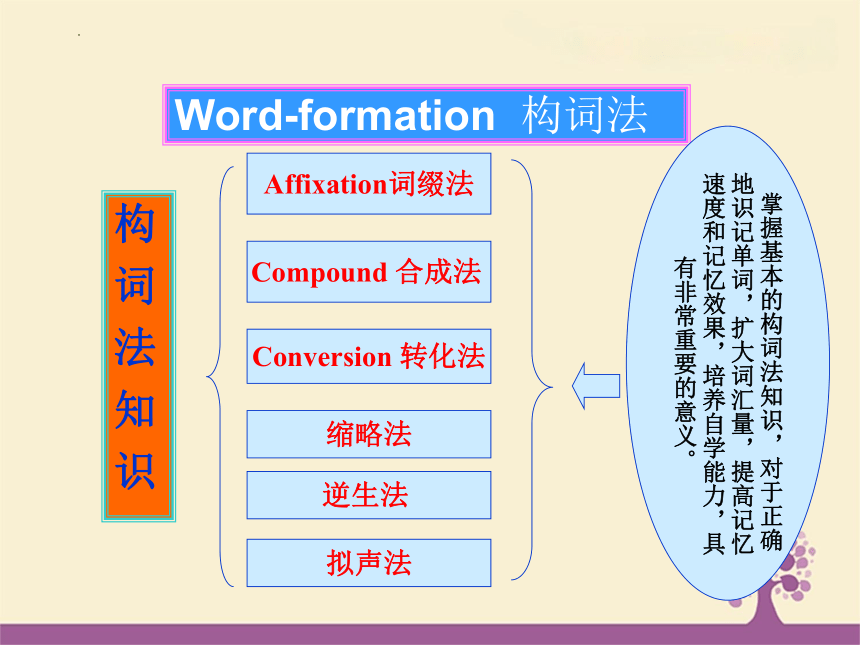

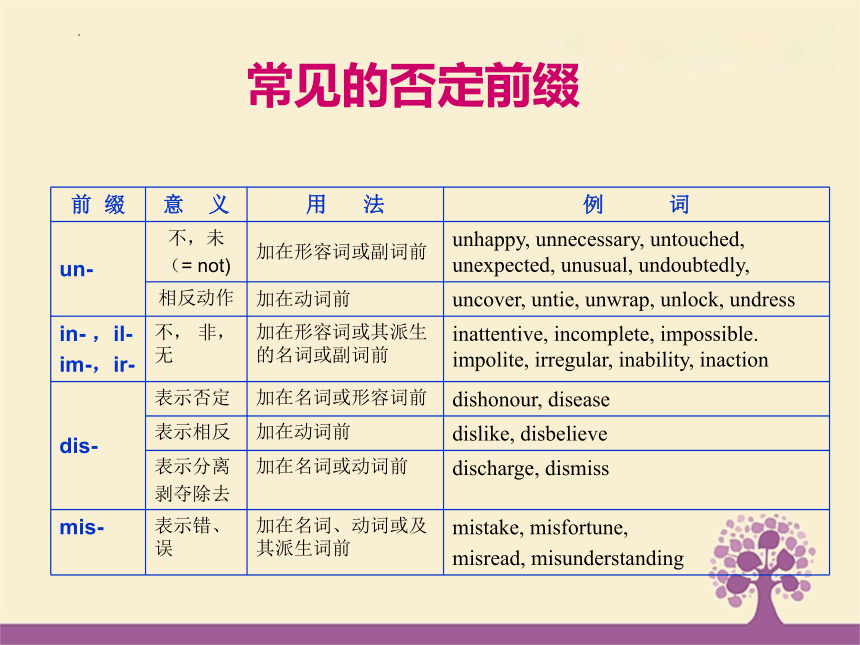
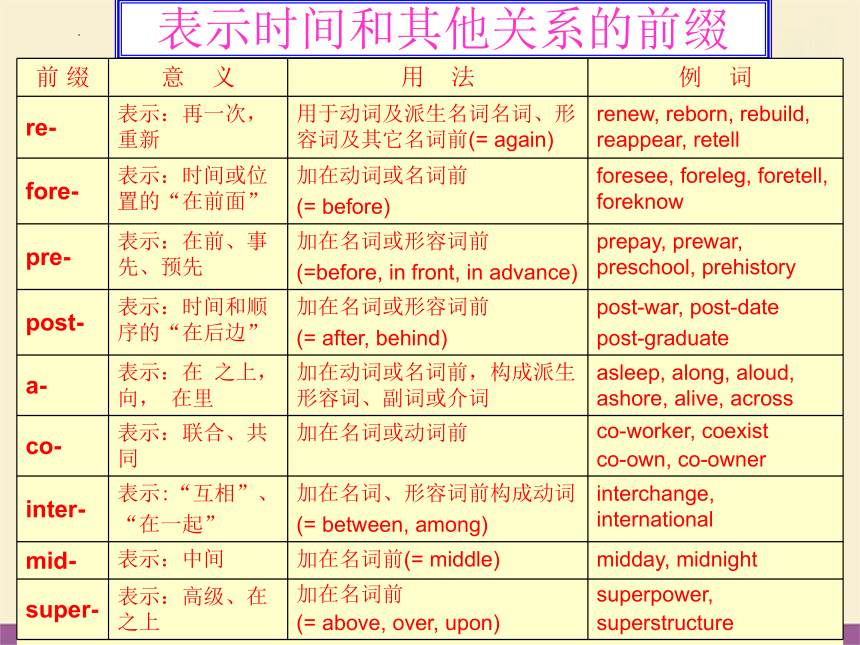

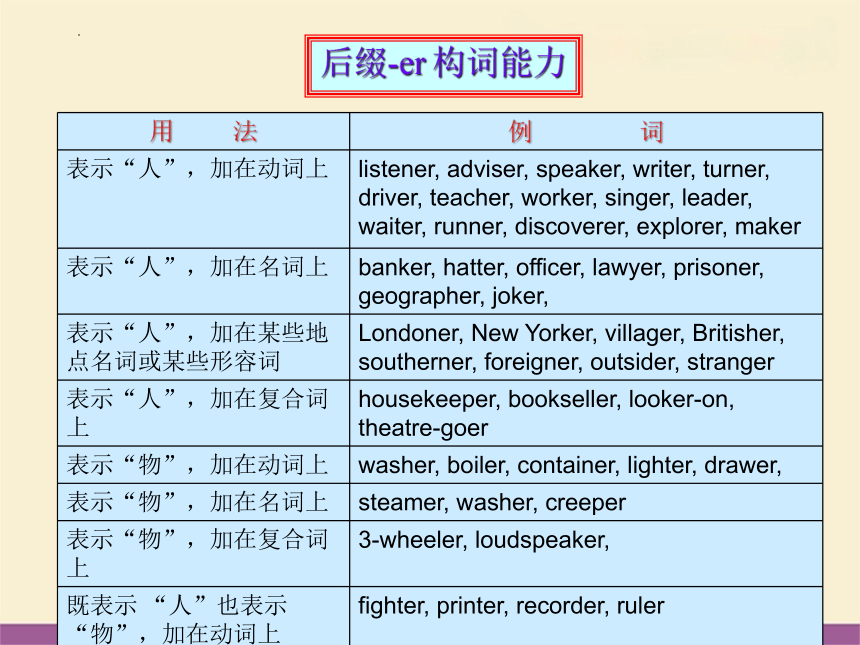
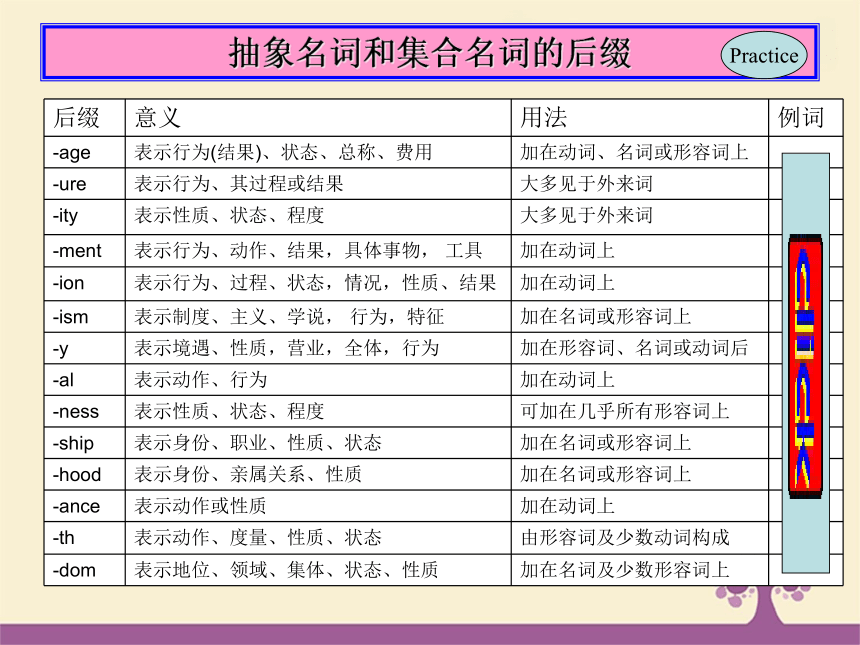
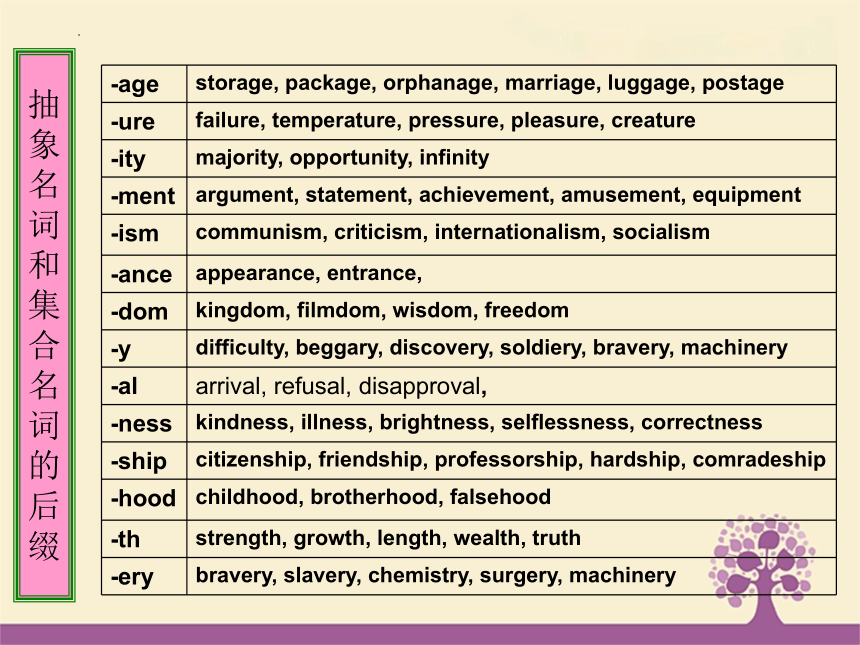
文档简介
(共30张PPT)
英语单词记忆方法与技巧
英语构词法
词素
词素: (Morpheme)最小的语法单位,也是最小的
语义单位
自由词素(free form):本身具有完整意义又
能构成一个词 独立使用的词素
boy, girl, desk, kind, cruel, give
粘着词素(bound morpheme):具有一定意
义,但不能独立存在,必须粘附在其
他形式上的词素
un- unnecessary
–less careless
词根(root):含有明确的词汇意义,在单词中起着 表达主要意义作用的词素(自由,粘着,组合语素)
词缀(affix):只有语法意义没有词汇意义或者有一 定词汇意义,但只表达次要的意义
unhappy careless friendliness
词根,词缀
词素,词根,词缀(区别与联系)
词汇意义 独立性
自由词素 完整 是
粘着词素 一定 否
词根 主要 自由词根:是
粘着词根:否
组合语素:否
词缀 无或次要 否
Word-formation 构词法
构
词
法
知
识
Affixation词缀法
Compound 合成法
Conversion 转化法
掌握基本的构词法知识,对于正确
地识记单词,扩大词汇量,提高记忆
速度和记忆效果,培养自学能力,具
有非常重要的意义。
缩略法
逆生法
拟声法
词缀法
词
缀
法
前缀
后缀
否定前缀
其他前缀
名词后缀
形容词后缀
副词后缀
动词后缀
常见的否定前缀
前 缀 意 义 用 法 例 词
un- 不,未 (= not) 加在形容词或副词前 unhappy, unnecessary, untouched, unexpected, unusual, undoubtedly,
相反动作 加在动词前 uncover, untie, unwrap, unlock, undress
in- ,il- im-,ir- 不, 非, 无 加在形容词或其派生的名词或副词前 inattentive, incomplete, impossible. impolite, irregular, inability, inaction
dis- 表示否定 加在名词或形容词前 dishonour, disease
表示相反 加在动词前 dislike, disbelieve
表示分离 剥夺除去 加在名词或动词前 discharge, dismiss
mis- 表示错、误 加在名词、动词或及其派生词前 mistake, misfortune,
misread, misunderstanding
表示时间和其他关系的前缀
前 缀 意 义 用 法 例 词
re- 表示:再一次,重新 用于动词及派生名词名词、形容词及其它名词前(= again) renew, reborn, rebuild, reappear, retell
fore- 表示:时间或位置的“在前面” 加在动词或名词前 (= before) foresee, foreleg, foretell, foreknow
pre- 表示:在前、事先、预先 加在名词或形容词前 (=before, in front, in advance) prepay, prewar, preschool, prehistory
post- 表示:时间和顺序的“在后边” 加在名词或形容词前 (= after, behind) post-war, post-date
post-graduate
a- 表示:在 之上, 向, 在里 加在动词或名词前,构成派生形容词、副词或介词 asleep, along, aloud, ashore, alive, across
co- 表示:联合、共同 加在名词或动词前 co-worker, coexist
co-own, co-owner
inter- 表示:“互相”、 “在一起” 加在名词、形容词前构成动词 (= between, among) interchange, international
mid- 表示:中间 加在名词前(= middle) midday, midnight
super- 表示:高级、在之上 加在名词前 (= above, over, upon) superpower,
superstructure
表示人和物的名词后缀
后缀 意 义 用 法 例词
表 示 人 -er 从事…职业的人,做…的人,…地方的人 加在动词、名词、形容词上 teacher, worker
learner, hatter
-or 与-er同义 外来后缀,加在外来词上 visitor, conductor
educator, translator
-eer 从事于...的人 用于外来词 engineer, volunteer
mountaineer
-ess 女...的 加于名词后,表示阴性 actress, waitress
-ician ...(专)家,...工作者 加在以-ic结尾的名词或形容词上 physician, politician
musician
-ist 从事...职业的人,从事某种...文艺、学术的人,...主义者 加在名词上,或 –ize 结尾的动词上,或以-al结尾的其它词上 artist, socialist
communist
physicist
表示物 -er 表示从事某工作的物 加在动词和名词或复合词上 washer, fiver
-or 表示从事某工作的物 加在动词上 conductor, receptor
用 法 例 词
表示“人”,加在动词上 listener, adviser, speaker, writer, turner, driver, teacher, worker, singer, leader, waiter, runner, discoverer, explorer, maker
表示“人”,加在名词上 banker, hatter, officer, lawyer, prisoner, geographer, joker,
表示“人”,加在某些地点名词或某些形容词 Londoner, New Yorker, villager, Britisher, southerner, foreigner, outsider, stranger
表示“人”,加在复合词上 housekeeper, bookseller, looker-on, theatre-goer
表示“物”,加在动词上 washer, boiler, container, lighter, drawer,
表示“物”,加在名词上 steamer, washer, creeper
表示“物”,加在复合词上 3-wheeler, loudspeaker,
既表示 “人”也表示“物”,加在动词上 fighter, printer, recorder, ruler
后缀-er 构词能力
抽象名词和集合名词的后缀
后缀 意义 用法 例词
-age 表示行为(结果)、状态、总称、费用 加在动词、名词或形容词上
-ure 表示行为、其过程或结果 大多见于外来词
-ity 表示性质、状态、程度 大多见于外来词
-ment 表示行为、动作、结果,具体事物, 工具 加在动词上
-ion 表示行为、过程、状态,情况,性质、结果 加在动词上
-ism 表示制度、主义、学说, 行为,特征 加在名词或形容词上
-y 表示境遇、性质,营业,全体,行为 加在形容词、名词或动词后
-al 表示动作、行为 加在动词上
-ness 表示性质、状态、程度 可加在几乎所有形容词上
-ship 表示身份、职业、性质、状态 加在名词或形容词上
-hood 表示身份、亲属关系、性质 加在名词或形容词上
-ance 表示动作或性质 加在动词上
-th 表示动作、度量、性质、状态 由形容词及少数动词构成
-dom 表示地位、领域、集体、状态、性质 加在名词及少数形容词上
Practice
抽象名词和集合名词的后缀
-age storage, package, orphanage, marriage, luggage, postage
-ure failure, temperature, pressure, pleasure, creature
-ity majority, opportunity, infinity
-ment argument, statement, achievement, amusement, equipment
-ism communism, criticism, internationalism, socialism
-ance appearance, entrance,
-dom kingdom, filmdom, wisdom, freedom
-y difficulty, beggary, discovery, soldiery, bravery, machinery
-al arrival, refusal, disapproval,
-ness kindness, illness, brightness, selflessness, correctness
-ship citizenship, friendship, professorship, hardship, comradeship
-hood childhood, brotherhood, falsehood
-th strength, growth, length, wealth, truth
-ery bravery, slavery, chemistry, surgery, machinery
后缀为-ion的名词
规 则 例 词
几乎所有以-ate结尾的动词在变为名词时首先去掉e再加-ion. educate/education, liberate/liberation, translate/translation,
graduate/graduation, separate/separation, operate/operation
多数以-t结尾的动词直接在词尾加-ion,少数以-te结尾的动词首先去掉e再加-ion. act/action, invent/invention, inspect/inspection, elect/election, select/selection, connect/connection, collect/collection,
instruct/instruction, devote/devotion, pollute/pollution
多数以-ss结尾的动词直接加-ion. discuss/discussion, oppress/oppression, express/expression,
confess/confession, possess/possession
多数以-de结尾与少数以-d结尾的动词先把-de或-d变成-s再加-ion. decide/decision, divide/division, provide/provision, invade/ invasion, expand/expansion, extend/extension
以-mit结尾的动词,先把t变成-ss,再加-ion. admit/admission, commit/commission, permit/permission,
transmit/transmission
多数以-fy结尾的动词先把y改成i再加-cation,少数以-efy或-fy结尾的动词先去掉y再加-action. Electrify/electrification, satisfy/satisfaction, modify/ modification,
Amplify/amplification
有些动词不是加-ion,而是加-ition, -tion, -ation或-sion而变成名词,其中有些词根因读音关系而发生了变化。 add/addition, attend/attention, absorb/absorption, describe/ description, produce/production, reduce/reduction, solve/ solution, determine/determination, explain/explanation, found/ foundation, observe/observation, transport/transportation
形容词后缀
后缀 意 义 用 法 例 词
-able 可/能…的 加在名词或及物动词后 valuable, horrible, eatable
-al 有... 性质的 加在名词后 natural, technical, actual
-ant, -ent ...的 加在外来动词词干上 important, pleasant, excellent
-ic, -ical ...性质的,与...有关的 加在外来词干的名词上 atomic, electric, basic
-ish 稍带...的,... 气的, ...民族的,... 语的 加在名词或形容词上 用于民族国家地名之上 feverish, childish, bookish
English, Spanish
-ive 有...倾向的/性质的 加在动词上 instructive, expensive
-ful 充满...的, 引起... 的 加在名词或少数名词上 thankful, powerful, tearful
-less 无/不...的,不能...的 加在名词或动词上 homeless, harmless, wireless
-ous 充满...的,有...特性的 加在名词上 dangerous, famous, nervous
-y 有/多... 的,想...的 加在名词上 cloudy, sunny, funny, sleepy
-ed 有...的, 有...特征的 加在名词或动词上 tired, interested, learned
-en 由...构(制)成的 加在物质名词上 wooden, earthen, woolen
-ern ...方的 加在表示方位的名词上 eastern, western, southern
-ly 有...性质的,...形状的 加在名词或形容词上 yearly, daily, orderly, lively
副词后缀
副词后缀
后缀 用法及意义 例词
-ly 加在形容词之后 表示某种状态 cheerfully, slightly, simply, possibly, coolly, excitedly
表示某个方面 economically, technically
表示程度或范围 greatly, completely
表示时间 recently, presently
表示次序 firstly, secondly
表示方向 eastwardly, northwardly
-ward -wards 加在名词或副词后,表示“向......的” forward, backward, upward,
downward, toward, northward, afterward
后缀 意 义 用 法 例 词
-ate 表示:使成为,成为..., 处理, 使化合 见于外来词,由外来词根组成,不能活用 educate, translate, imitate,
calculate, operate, hesitate, concentrate, evaporate
-en 表示: 变为,使为,变为有,使有 加在形容词上,有时加在名词上,通常构成及物动词 darken, weaken, deepen, sharpen, glisten, frighten, strengthen
-fy 表示:使成为,使...化 加在名词或形容词上,构成及物动词和少数不及物动词 beautify, uglify, satisfy, terrify, electrify, purify
-ish 表示: 使..., 令... 大多是从法语输入的词, 不能构成新词 finish, accomplish, punish, furnish, publish, astonish
-ize -ize 表示: 使成, 变成,...化 加在名词或形容词上,构成及物动词或少数不及物动词 modernize, democratize, revolutionize, realize, sympathize
动 词 后 缀
Compound 合成法
把两个或两个以上的词合成一个新
词, 这种构词的方法叫做合成法
合
成
法
1. 直接写在一起。
2. 用连字符(-)连接。
3. 由两个分开的词构成。
方法
概念
方式
1. 复合形容词的构成
2. 复合名词的构成。
3. 其他复合词的构成。
复合名词的构成
方式 例词
名词+名词 horseback , bank-note, newspaper, cell-phone
形容词+名词 back-yard, forehead, greenhouse, blackboard
动名词+名词 hiding-place, reading-room
动词+副词 get-off, break-in, breakdown, breakup
副词+动词 output, overflow
动词+名词 pickpocket , break-water
副词+名词 overcoat, inland
代词+名词 he-goat, she-wolf
名词+介词+名词 editor-in-chief, father-in-law
复合形容词的构成
方式 例 词
形容词+形容词 red-hot,bitter-sweet, dark-blue
形容词+名词 first-class, full-time, part-time, second-hand, bare-foot
形容词+现在分词 good-looking, free-thinking, hard-working
形容词+过去分词 ready-made
形容词+名词-ed good-tempered, middle-aged, cold-blooded
名词+名词-ed iron-willed
名词+形容词 world-famous,snow-white, seasick, lifelong
名词+现在分词 beauty-loving, freedom-loving, job-hunting, time-saving
名词+过去分词 man-made, water-covered, snow-covered, hand-made
副词+形容词 ever-green, over-sensitive
副词+现在分词 hard-working, far-seeing, far-reaching, well-meaning
副词+过去分词 well-prepared, quickly-cured, well-known
数词+名词 five-year,
数词+名词+形容词 five-year-old, six-inch-tall
数词+名词-ed four-legged, six-storied , two-faced, four-cornered
其他复合词的构成
方式 例 词
复合动词 名词+动词 day-dream,sun-bathe
副词+动词 overcome, upturn,overcome, upho1d, outgrow
形容词+动词 white-wash
复合副词 名词+名词 sideways
名词+副词 headfirst
形容词+名词 meanwhile
介词+名词 beforehand
复合代词 代词宾格或物主代词 + self (selves) himself, ourselves
某些不定代词 + body (one, thing) everyone (everybody, everything), nobody (no one, nothing)
一、请找出下列句中的合成词, 并说明构成的类型并指出其意义。
1. This fully updated book features the latest information about study opportunities.
即时练习
2. It is said that a short-tempered man in the Song Dynasty(960-1279) was very anxious to help his rice crop grow up quickly.
2. short-tempered 副词+分词→形容词 易怒的
3. If you find that believing in yourself is a challenge, it is time you build a positive self-image and learn to love yourself.
3. self-image 名词+名词→名词 自我形象
4. He is said to be “undersized,” with “short legs” and a “round stomach”.
4. undersized副词+分词→形容词 个子小的
5. Not all of these fairies are the friendly, people-loving characters that appear in Disney films and in some folktales, they are cruel.
5. people-loving 名词+分词→形容词 热爱人们的
6. There are more outbreaks in cities with large populations.
6. outbreaks 副词+名词→名词 爆发
7. I enclose a self-addressed envelope.
7. self-addressed 名词+分词→形容词 写明发信人自己的地址的
转化法 Conversion
转
化
法
概念
方式
英语中有些单词,词形不变, 词性
却可以由一种转化成另一种。
一个单词由某一种词类转用为另
一种词类, 这就是转化。
单词转换后的意义往往与未转换
前的意义有密切的联系。
1. 名词和动词之间的转化
2. 形容词转化为动词
3. 名词转化为形容词(副词)
4. 形容词转化为名词
名词转化为动词 形容词转化为动词 名词转化为形容词 副词转换为动词
telephone 电话→打电话 slow 慢的→放慢 front前面→前面的 down 向下→击倒
hand手 → 交给 warm 暖的→使温暖 black 黑色→黑色的 back向后→后退
record 录音→记录 empty 空的→倒空 noble 贵族→高贵的 up 向上→提高
date 日期→ 定日期 better 较好→ 改善 key 钥匙 →关键的
name 名字→ 命名 cool 凉爽 →使冷
face 脸 → 面对
动词转化为名词 动词转化为形容词 形容词转化为名词 一些形容词前加the后转换为名词
drink 喝→饮料 perfect 使完善→完美的 chief 主要的→首领 the wounded
受伤的人们
study 学习→书房 fit 适合 → 适合的 first 第一的 → 第一个 the blind盲人们
look at → have a look at wrong 错误的 → 错 误 the beautiful
美丽的东西
转化法例释
即时练习
根据红色字体词在句中所作句子成分, 判断其词性及其意义。
Only thus can we better the life of the people.
1. 动词 改善
2. They finally freed themselves from slavery.
2. 动词 使自由
3. He adjusted the lathe and readied the cutting tool.
3. 动词 准备好
4. He's my dear.
4. 名词 亲爱的人
5. He presented his opposed opinion at the meeting.
5. 动词 提出
6. She busied herself with household work.
6. 动词 使忙碌
7.He lit a candle to light the room.
7. 动词 照亮
That’s all!
Thank you!
英语单词记忆方法与技巧
英语构词法
词素
词素: (Morpheme)最小的语法单位,也是最小的
语义单位
自由词素(free form):本身具有完整意义又
能构成一个词 独立使用的词素
boy, girl, desk, kind, cruel, give
粘着词素(bound morpheme):具有一定意
义,但不能独立存在,必须粘附在其
他形式上的词素
un- unnecessary
–less careless
词根(root):含有明确的词汇意义,在单词中起着 表达主要意义作用的词素(自由,粘着,组合语素)
词缀(affix):只有语法意义没有词汇意义或者有一 定词汇意义,但只表达次要的意义
unhappy careless friendliness
词根,词缀
词素,词根,词缀(区别与联系)
词汇意义 独立性
自由词素 完整 是
粘着词素 一定 否
词根 主要 自由词根:是
粘着词根:否
组合语素:否
词缀 无或次要 否
Word-formation 构词法
构
词
法
知
识
Affixation词缀法
Compound 合成法
Conversion 转化法
掌握基本的构词法知识,对于正确
地识记单词,扩大词汇量,提高记忆
速度和记忆效果,培养自学能力,具
有非常重要的意义。
缩略法
逆生法
拟声法
词缀法
词
缀
法
前缀
后缀
否定前缀
其他前缀
名词后缀
形容词后缀
副词后缀
动词后缀
常见的否定前缀
前 缀 意 义 用 法 例 词
un- 不,未 (= not) 加在形容词或副词前 unhappy, unnecessary, untouched, unexpected, unusual, undoubtedly,
相反动作 加在动词前 uncover, untie, unwrap, unlock, undress
in- ,il- im-,ir- 不, 非, 无 加在形容词或其派生的名词或副词前 inattentive, incomplete, impossible. impolite, irregular, inability, inaction
dis- 表示否定 加在名词或形容词前 dishonour, disease
表示相反 加在动词前 dislike, disbelieve
表示分离 剥夺除去 加在名词或动词前 discharge, dismiss
mis- 表示错、误 加在名词、动词或及其派生词前 mistake, misfortune,
misread, misunderstanding
表示时间和其他关系的前缀
前 缀 意 义 用 法 例 词
re- 表示:再一次,重新 用于动词及派生名词名词、形容词及其它名词前(= again) renew, reborn, rebuild, reappear, retell
fore- 表示:时间或位置的“在前面” 加在动词或名词前 (= before) foresee, foreleg, foretell, foreknow
pre- 表示:在前、事先、预先 加在名词或形容词前 (=before, in front, in advance) prepay, prewar, preschool, prehistory
post- 表示:时间和顺序的“在后边” 加在名词或形容词前 (= after, behind) post-war, post-date
post-graduate
a- 表示:在 之上, 向, 在里 加在动词或名词前,构成派生形容词、副词或介词 asleep, along, aloud, ashore, alive, across
co- 表示:联合、共同 加在名词或动词前 co-worker, coexist
co-own, co-owner
inter- 表示:“互相”、 “在一起” 加在名词、形容词前构成动词 (= between, among) interchange, international
mid- 表示:中间 加在名词前(= middle) midday, midnight
super- 表示:高级、在之上 加在名词前 (= above, over, upon) superpower,
superstructure
表示人和物的名词后缀
后缀 意 义 用 法 例词
表 示 人 -er 从事…职业的人,做…的人,…地方的人 加在动词、名词、形容词上 teacher, worker
learner, hatter
-or 与-er同义 外来后缀,加在外来词上 visitor, conductor
educator, translator
-eer 从事于...的人 用于外来词 engineer, volunteer
mountaineer
-ess 女...的 加于名词后,表示阴性 actress, waitress
-ician ...(专)家,...工作者 加在以-ic结尾的名词或形容词上 physician, politician
musician
-ist 从事...职业的人,从事某种...文艺、学术的人,...主义者 加在名词上,或 –ize 结尾的动词上,或以-al结尾的其它词上 artist, socialist
communist
physicist
表示物 -er 表示从事某工作的物 加在动词和名词或复合词上 washer, fiver
-or 表示从事某工作的物 加在动词上 conductor, receptor
用 法 例 词
表示“人”,加在动词上 listener, adviser, speaker, writer, turner, driver, teacher, worker, singer, leader, waiter, runner, discoverer, explorer, maker
表示“人”,加在名词上 banker, hatter, officer, lawyer, prisoner, geographer, joker,
表示“人”,加在某些地点名词或某些形容词 Londoner, New Yorker, villager, Britisher, southerner, foreigner, outsider, stranger
表示“人”,加在复合词上 housekeeper, bookseller, looker-on, theatre-goer
表示“物”,加在动词上 washer, boiler, container, lighter, drawer,
表示“物”,加在名词上 steamer, washer, creeper
表示“物”,加在复合词上 3-wheeler, loudspeaker,
既表示 “人”也表示“物”,加在动词上 fighter, printer, recorder, ruler
后缀-er 构词能力
抽象名词和集合名词的后缀
后缀 意义 用法 例词
-age 表示行为(结果)、状态、总称、费用 加在动词、名词或形容词上
-ure 表示行为、其过程或结果 大多见于外来词
-ity 表示性质、状态、程度 大多见于外来词
-ment 表示行为、动作、结果,具体事物, 工具 加在动词上
-ion 表示行为、过程、状态,情况,性质、结果 加在动词上
-ism 表示制度、主义、学说, 行为,特征 加在名词或形容词上
-y 表示境遇、性质,营业,全体,行为 加在形容词、名词或动词后
-al 表示动作、行为 加在动词上
-ness 表示性质、状态、程度 可加在几乎所有形容词上
-ship 表示身份、职业、性质、状态 加在名词或形容词上
-hood 表示身份、亲属关系、性质 加在名词或形容词上
-ance 表示动作或性质 加在动词上
-th 表示动作、度量、性质、状态 由形容词及少数动词构成
-dom 表示地位、领域、集体、状态、性质 加在名词及少数形容词上
Practice
抽象名词和集合名词的后缀
-age storage, package, orphanage, marriage, luggage, postage
-ure failure, temperature, pressure, pleasure, creature
-ity majority, opportunity, infinity
-ment argument, statement, achievement, amusement, equipment
-ism communism, criticism, internationalism, socialism
-ance appearance, entrance,
-dom kingdom, filmdom, wisdom, freedom
-y difficulty, beggary, discovery, soldiery, bravery, machinery
-al arrival, refusal, disapproval,
-ness kindness, illness, brightness, selflessness, correctness
-ship citizenship, friendship, professorship, hardship, comradeship
-hood childhood, brotherhood, falsehood
-th strength, growth, length, wealth, truth
-ery bravery, slavery, chemistry, surgery, machinery
后缀为-ion的名词
规 则 例 词
几乎所有以-ate结尾的动词在变为名词时首先去掉e再加-ion. educate/education, liberate/liberation, translate/translation,
graduate/graduation, separate/separation, operate/operation
多数以-t结尾的动词直接在词尾加-ion,少数以-te结尾的动词首先去掉e再加-ion. act/action, invent/invention, inspect/inspection, elect/election, select/selection, connect/connection, collect/collection,
instruct/instruction, devote/devotion, pollute/pollution
多数以-ss结尾的动词直接加-ion. discuss/discussion, oppress/oppression, express/expression,
confess/confession, possess/possession
多数以-de结尾与少数以-d结尾的动词先把-de或-d变成-s再加-ion. decide/decision, divide/division, provide/provision, invade/ invasion, expand/expansion, extend/extension
以-mit结尾的动词,先把t变成-ss,再加-ion. admit/admission, commit/commission, permit/permission,
transmit/transmission
多数以-fy结尾的动词先把y改成i再加-cation,少数以-efy或-fy结尾的动词先去掉y再加-action. Electrify/electrification, satisfy/satisfaction, modify/ modification,
Amplify/amplification
有些动词不是加-ion,而是加-ition, -tion, -ation或-sion而变成名词,其中有些词根因读音关系而发生了变化。 add/addition, attend/attention, absorb/absorption, describe/ description, produce/production, reduce/reduction, solve/ solution, determine/determination, explain/explanation, found/ foundation, observe/observation, transport/transportation
形容词后缀
后缀 意 义 用 法 例 词
-able 可/能…的 加在名词或及物动词后 valuable, horrible, eatable
-al 有... 性质的 加在名词后 natural, technical, actual
-ant, -ent ...的 加在外来动词词干上 important, pleasant, excellent
-ic, -ical ...性质的,与...有关的 加在外来词干的名词上 atomic, electric, basic
-ish 稍带...的,... 气的, ...民族的,... 语的 加在名词或形容词上 用于民族国家地名之上 feverish, childish, bookish
English, Spanish
-ive 有...倾向的/性质的 加在动词上 instructive, expensive
-ful 充满...的, 引起... 的 加在名词或少数名词上 thankful, powerful, tearful
-less 无/不...的,不能...的 加在名词或动词上 homeless, harmless, wireless
-ous 充满...的,有...特性的 加在名词上 dangerous, famous, nervous
-y 有/多... 的,想...的 加在名词上 cloudy, sunny, funny, sleepy
-ed 有...的, 有...特征的 加在名词或动词上 tired, interested, learned
-en 由...构(制)成的 加在物质名词上 wooden, earthen, woolen
-ern ...方的 加在表示方位的名词上 eastern, western, southern
-ly 有...性质的,...形状的 加在名词或形容词上 yearly, daily, orderly, lively
副词后缀
副词后缀
后缀 用法及意义 例词
-ly 加在形容词之后 表示某种状态 cheerfully, slightly, simply, possibly, coolly, excitedly
表示某个方面 economically, technically
表示程度或范围 greatly, completely
表示时间 recently, presently
表示次序 firstly, secondly
表示方向 eastwardly, northwardly
-ward -wards 加在名词或副词后,表示“向......的” forward, backward, upward,
downward, toward, northward, afterward
后缀 意 义 用 法 例 词
-ate 表示:使成为,成为..., 处理, 使化合 见于外来词,由外来词根组成,不能活用 educate, translate, imitate,
calculate, operate, hesitate, concentrate, evaporate
-en 表示: 变为,使为,变为有,使有 加在形容词上,有时加在名词上,通常构成及物动词 darken, weaken, deepen, sharpen, glisten, frighten, strengthen
-fy 表示:使成为,使...化 加在名词或形容词上,构成及物动词和少数不及物动词 beautify, uglify, satisfy, terrify, electrify, purify
-ish 表示: 使..., 令... 大多是从法语输入的词, 不能构成新词 finish, accomplish, punish, furnish, publish, astonish
-ize -ize 表示: 使成, 变成,...化 加在名词或形容词上,构成及物动词或少数不及物动词 modernize, democratize, revolutionize, realize, sympathize
动 词 后 缀
Compound 合成法
把两个或两个以上的词合成一个新
词, 这种构词的方法叫做合成法
合
成
法
1. 直接写在一起。
2. 用连字符(-)连接。
3. 由两个分开的词构成。
方法
概念
方式
1. 复合形容词的构成
2. 复合名词的构成。
3. 其他复合词的构成。
复合名词的构成
方式 例词
名词+名词 horseback , bank-note, newspaper, cell-phone
形容词+名词 back-yard, forehead, greenhouse, blackboard
动名词+名词 hiding-place, reading-room
动词+副词 get-off, break-in, breakdown, breakup
副词+动词 output, overflow
动词+名词 pickpocket , break-water
副词+名词 overcoat, inland
代词+名词 he-goat, she-wolf
名词+介词+名词 editor-in-chief, father-in-law
复合形容词的构成
方式 例 词
形容词+形容词 red-hot,bitter-sweet, dark-blue
形容词+名词 first-class, full-time, part-time, second-hand, bare-foot
形容词+现在分词 good-looking, free-thinking, hard-working
形容词+过去分词 ready-made
形容词+名词-ed good-tempered, middle-aged, cold-blooded
名词+名词-ed iron-willed
名词+形容词 world-famous,snow-white, seasick, lifelong
名词+现在分词 beauty-loving, freedom-loving, job-hunting, time-saving
名词+过去分词 man-made, water-covered, snow-covered, hand-made
副词+形容词 ever-green, over-sensitive
副词+现在分词 hard-working, far-seeing, far-reaching, well-meaning
副词+过去分词 well-prepared, quickly-cured, well-known
数词+名词 five-year,
数词+名词+形容词 five-year-old, six-inch-tall
数词+名词-ed four-legged, six-storied , two-faced, four-cornered
其他复合词的构成
方式 例 词
复合动词 名词+动词 day-dream,sun-bathe
副词+动词 overcome, upturn,overcome, upho1d, outgrow
形容词+动词 white-wash
复合副词 名词+名词 sideways
名词+副词 headfirst
形容词+名词 meanwhile
介词+名词 beforehand
复合代词 代词宾格或物主代词 + self (selves) himself, ourselves
某些不定代词 + body (one, thing) everyone (everybody, everything), nobody (no one, nothing)
一、请找出下列句中的合成词, 并说明构成的类型并指出其意义。
1. This fully updated book features the latest information about study opportunities.
即时练习
2. It is said that a short-tempered man in the Song Dynasty(960-1279) was very anxious to help his rice crop grow up quickly.
2. short-tempered 副词+分词→形容词 易怒的
3. If you find that believing in yourself is a challenge, it is time you build a positive self-image and learn to love yourself.
3. self-image 名词+名词→名词 自我形象
4. He is said to be “undersized,” with “short legs” and a “round stomach”.
4. undersized副词+分词→形容词 个子小的
5. Not all of these fairies are the friendly, people-loving characters that appear in Disney films and in some folktales, they are cruel.
5. people-loving 名词+分词→形容词 热爱人们的
6. There are more outbreaks in cities with large populations.
6. outbreaks 副词+名词→名词 爆发
7. I enclose a self-addressed envelope.
7. self-addressed 名词+分词→形容词 写明发信人自己的地址的
转化法 Conversion
转
化
法
概念
方式
英语中有些单词,词形不变, 词性
却可以由一种转化成另一种。
一个单词由某一种词类转用为另
一种词类, 这就是转化。
单词转换后的意义往往与未转换
前的意义有密切的联系。
1. 名词和动词之间的转化
2. 形容词转化为动词
3. 名词转化为形容词(副词)
4. 形容词转化为名词
名词转化为动词 形容词转化为动词 名词转化为形容词 副词转换为动词
telephone 电话→打电话 slow 慢的→放慢 front前面→前面的 down 向下→击倒
hand手 → 交给 warm 暖的→使温暖 black 黑色→黑色的 back向后→后退
record 录音→记录 empty 空的→倒空 noble 贵族→高贵的 up 向上→提高
date 日期→ 定日期 better 较好→ 改善 key 钥匙 →关键的
name 名字→ 命名 cool 凉爽 →使冷
face 脸 → 面对
动词转化为名词 动词转化为形容词 形容词转化为名词 一些形容词前加the后转换为名词
drink 喝→饮料 perfect 使完善→完美的 chief 主要的→首领 the wounded
受伤的人们
study 学习→书房 fit 适合 → 适合的 first 第一的 → 第一个 the blind盲人们
look at → have a look at wrong 错误的 → 错 误 the beautiful
美丽的东西
转化法例释
即时练习
根据红色字体词在句中所作句子成分, 判断其词性及其意义。
Only thus can we better the life of the people.
1. 动词 改善
2. They finally freed themselves from slavery.
2. 动词 使自由
3. He adjusted the lathe and readied the cutting tool.
3. 动词 准备好
4. He's my dear.
4. 名词 亲爱的人
5. He presented his opposed opinion at the meeting.
5. 动词 提出
6. She busied herself with household work.
6. 动词 使忙碌
7.He lit a candle to light the room.
7. 动词 照亮
That’s all!
Thank you!
